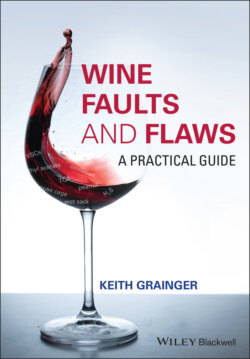Читать книгу Wine Faults and Flaws - Keith Grainger - Страница 79
2.7.6 Alcohol
ОглавлениеAlcohol is the most abundant volatile compound in wine. It is detected on the palate as a warming sensation, perceived at the back of the tongue, the cheeks and in the mouth generally. The higher the level of alcohol, the more of a warm ‘glow’ will be perceived by the taster. Alcohol also gives a combination of sweet and bitter tastes, and bitterness increases with higher alcohol levels [13]. Over‐alcoholic wines will give burning sensations, and this may be considered to be a flaw (see Chapter 14). The ‘weight’ of the wine in the mouth also increases with the concentration of alcohol.
With an increase in the level of alcohol, there is a decrease in the volatility of wine aroma compounds.
The alcoholic content of light, i.e. unfortified wines, ranges from 7.5% to 16% abv (alcohol by volume). As grapes ripen, the levels of fructose and glucose increase, thus increasing the potential amount of alcohol. Generally speaking, wines from hotter climates contain more alcohol than those from cooler regions. However, the average alcohol level of wines has increased during the last two or three decades. This is due to many reasons, including changes in canopy management, growers delaying harvesting until so‐called phenolic ripeness is reached (especially as the market now demands a softer style of reds than in the past), the impact of climate change and the use of cultured, alcohol tolerant yeasts. In 1989, referring to Australian Cabernet Sauvignons, Bryce Rankine wrote in the reference work Making Good Wine: ‘A ripeness of 10°–12° Baumé (18–21.6° Brix) is usual, which results in a wine containing between about 10% and 12% alcohol by volume’ [14]. Today, any Australian Cabernet Sauvignon with less than 13% abv would be regarded as atypical – probably over‐cropped and certainly under‐ripe. Alcohol levels in white wines can range from as low 7.5% abv (e.g. some Riesling wines from Germany's Mosel region), up to 14.5% abv (e.g. some Californian Chardonnays). Red wines may range from 11% abv (e.g. some Bardolinos from Italy's Veneto region) up to 15% or more (e.g. some Chilean Cabernet Sauvignons). There is not much point in the taster attempting to estimate the actual alcoholic degree, (or the actual level of acidity) – it is the impression rather than quantification that is relevant. There are methods of removing alcohol from over‐alcoholic wines, including the use of reverse osmosis (RO) machines or spinning cone columns, but these remain controversial.
If a fortified wine is being assessed, the alcohol will be in the range of 15–22% abv. We consider whether the wine has been fortified to a low level (15–16% abv), e.g. Fino Sherry or Muscat de Beaumes de Venise, a medium level (17–19% abv), e.g. Sherries other than Fino/Manzanilla, some vin doux naturels (VDNs), or a high level (20% abv or more), e.g. Port. The presence of the ‘hot’ aromas or palate that shows spirit tones indicate a flaw, as the spirit addition to fortified wines should be seamlessly integrated.
